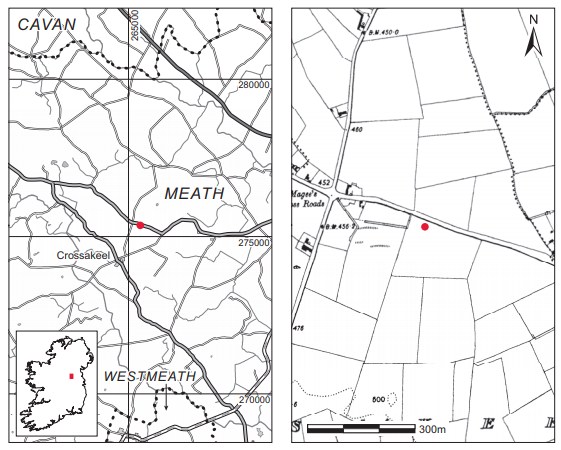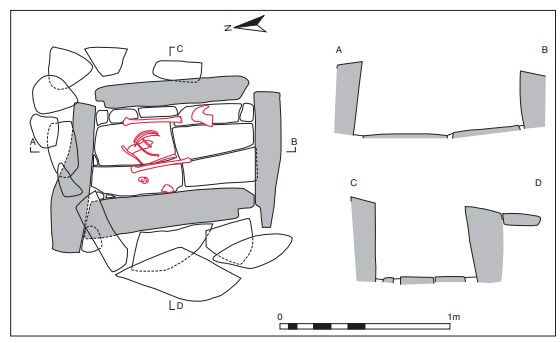County: Meath Site name: CROSSAKEEL, CO. MEATH
Sites and Monuments Record No.: SMR ME016-030 Licence number: E1132
Author: MARY CAHILL
Site type: Early Bronze Age graves
Period/Dating: —
ITM: E 665316m, N 775377m
Latitude, Longitude (decimal degrees): 53.723970, -7.010291
Introduction
In March 1983 a short cist containing an inhumation was discovered during land clearance in the garden of a dwelling house near Kells, Co. Meath. The capstone of the cist was struck first by the bulldozer, and when this was lifted human remains were noticed in the cist. The site was reported to the NMI by Sergeant McNulty of Kells Garda Station. A rescue excavation was undertaken by Mary Cahill, assisted by Adrian Kennedy, and the human remains were analysed by Laureen Buckley.
Location (Fig. 3.131)
The site was in the townland of Crossakeel, approximately 7km west of Kells, west Co. Meath,236 at an altitude of approximately 140m above sea level. In the 1880s a portion of a bowl was found in the same townland, although the exact location is not known (Waddell 1990, 123).237
Description of site
The grave consisted of a short rectangular cist with its long axis aligned north/south. Internally, it measured 0.97m long by 0.54m wide by 0.4m high and was formed of four shale slabs, one at each wall (Fig. 3.132). These slabs appear to have been of substantial proportions, the maximum dimensions being 0.98m long by 0.22m thick by 0.48m high. The slabs were probably originally tightly fitted together, but the western side slab had moved out slightly from the northern and southern end slabs. The southern end slab was split longitudinally. A number of packing stones were visible outside the cist, the majority at the west side, and some had been placed over the side slab at the northern end. The floor of the cist was paved with four rectangular slabs, and the gap between these and the eastern wall was paved with smaller filler stones. The cist was covered with a large, irregularly shaped capstone, which had split across the centre. The pit dug to receive the cist was not clearly defined.


The cist contained an inhumation of an adult male (1985:15) and no accompanying artefacts were found. As the remains were completely disturbed, it was not possible to ascertain the original disposition of the burial, apart from the location of the skull, which appears to have been placed against and facing the western wall of the cist.
Comment
The remains from the cist investigated in 1983 have not been dated. In the absence of any associated finds, it is assumed to be early Bronze Age on the basis of form. Ó Ríordáin and Waddell (1993, 123) give records of the discovery of two tripartite bowls (1874:7/Wk 36 and 1874:8/Wk 8) in a cist at Crossakeel in 1874, and another anomalous vessel (1935:869) was found c. 1880 at Seymourstown Black, near Crossakeel. These were donated by Morgan Rotherham of Belview, Crossakeel. He was the father of the well-known antiquarian and collector Edward Crofton Rotherham, who undertook various surveys and investigations in the area. There are no details available of the precise find-places but, given that the present site was found to contain no pottery, there may be some possibility that one or more of the vessels mentioned above might have been removed from a cist discovered in the late nineteenth century which was then rediscovered in 1983.
HUMAN REMAINS
LAUREEN BUCKLEY
Late middle/older adult male, 176cm (1985:15)
The bones were very decayed, although most skeletal elements seem to have been present. It was mainly the back of the skull that survived: the occipital bone, the posterior part of the left parietal bone and the mastoid areas of the temporal bones. Some fragments of the anterior parts of the parietal bones and a few small fragments of frontal bone also survived. Part of the mandible was present. Only the bodies of the three lower lumbar vertebrae remained. There were five ribs from the left side and eleven from the right side, and the manubrium and most of the body of the sternum were present.
The right scapula was virtually complete, but only the glenoid area remained from the left scapula. Most of the left clavicle, apart from the lateral end, was present, as was the shaft of the right clavicle. Both humeri were complete, although some of the distal end of the right bone was missing. The left radius was virtually complete except for a small fragment of shaft, and the left ulna was missing only the distal end. Only the proximal third remained from the right ulna. The left hand was missing; the right hand consisted of the trapezium, trapezoid, capitate and hamate, all the metacarpals and four proximal phalanges.
The pelvis consisted of fragments of both ilia and the right ischium. The left femur was almost complete, although the proximal end was missing and the distal end was fragmented, and the right femur was complete. The left tibia was almost complete apart from some of the joint ends, and the distal two-thirds of the right tibia remained. Only the left talus, calcaneus, navicular and the fourth and fifth metatarsals were present from the left foot, and the right foot was missing.
Age and sex
It was not possible to ascertain the sex from the skull because it was too decayed and the mastoid processes were broken. No observable features remained from the pelvis that would enable sex to be determined. Nevertheless, the diameter of the right femoral head, the bicondylar width of the left femur, the diameter of the humeri heads and the width of the glenoid cavity were all definitely in the male range. It is therefore highly probable that this is a male skeleton.
There were no features left that could be used to estimate the age of the individual. The first costal cartilage was ossified, however, so it is likely that this was a middle-aged or older adult. Based on the length of the femur, stature was estimated at 176cm.
Skeletal pathology
Some of the bones were encrusted with mineral deposits. This can happen if the cist is relatively watertight and the bones lie in water for some time. In this skeleton the joint ends were particularly badly encrusted, and this made examination for pathology difficult. In addition, the pelvis and proximal left femur were covered in a matted brown material that was probably grass roots. Some degeneration of joints was noted; the inferior part of the olecranon of the right ulna had mild marginal lipping. In the vertebrae there was a moderate degree of porosity of the inferior surface of the body of L3, severe osteophytes around the superior edges of the bodies of L4 and L5, and mild osteophytes on the inferior surface of the body of L4.
Dentition

The teeth were in very bad condition, with the enamel flaking off.
Attrition
There was moderate wear on the first molars and light wear on the other teeth.
Calculus
Deposits were light on the lingual surfaces of the right second premolar and first and second molars, moderate on the buccal surface of the upper right third molar and heavy on the lingual surfaces of the lower left first and second molars.
Summary
This was the skeleton of an adult male in very poor condition. It was not possible to obtain an accurate estimate of age at death but the individual may have been middle-aged or older. Examination of the bones was difficult as they were heavily encrusted with mineral deposits, but some slight evidence of degenerative disease was noted in the vertebral column and the elbow joint. The teeth were in a very poor state, with the enamel flaking off, but they did not appear to be heavily worn and there was no evidence for caries.
236. Parish of Kilskeer, barony of Upper Kells. SMR ME016-030——. IGR 265380 275360.
237. 1935: 869.